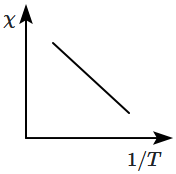Select Chapter Topics:
An iron bar of length \(\mathrm L\) has magnetic moment \(\mathrm M.\) It is bent at the middle of its length such that the two arms make an angle \(60^\circ\) with each other. The magnetic moment of this new magnet is:
1. \( \mathrm M \over 2\)
2. \( \mathrm {2 M}\)
3. \(\)\(\frac{\mathrm{M}}{\sqrt{3}}\)
4. \(\mathrm M\)
Subtopic: Bar Magnet |
From NCERT
NEET - 2024
Please attempt this question first.
Hints
Please attempt this question first.
The length of a magnetized iron bar is \(L\) and its magnetic moment is \(M.\) When this bar is bent to form a semicircle its magnetic moment is:
1. \(M\)
2. \(\large\frac{M\pi}{2}\)
3. \(\large\frac{M}{2\pi}\)
4. \(\large\frac{2M}{\pi}\)
1. \(M\)
2. \(\large\frac{M\pi}{2}\)
3. \(\large\frac{M}{2\pi}\)
4. \(\large\frac{2M}{\pi}\)
Subtopic: Bar Magnet |
70%
From NCERT
NEET - 2024
Please attempt this question first.
Hints
Please attempt this question first.
Match List-I with List-II
Choose the correct answer from the options given below:
1. A-I, B-II, C-III, D-IV
2. A-IV,B-III, C-II, D-I
3. A-III, B-II, C-I, D-IV
4. A-II, B-III, C-IV, D-I
| List-I (Material) |
List-II (Example) |
||
| A. | Diamagnet | I. | Alnico |
| B. | Paramagnet | II. | Copper |
| C. | Soft ferromagnet | III. | Aluminium |
| D. | Hard ferromagnet | IV. | Gadolinium |
1. A-I, B-II, C-III, D-IV
2. A-IV,B-III, C-II, D-I
3. A-III, B-II, C-I, D-IV
4. A-II, B-III, C-IV, D-I
Subtopic: Magnetic Materials |
From NCERT
NEET - 2024
Please attempt this question first.
Hints
Please attempt this question first.
The best suited curve showing the variations of susceptibility (\(\chi\)) of a paramagnetic material in free space with temperature (\(T\)) is:
| 1. |  |
2. |  |
| 3. |  |
4. |  |
Subtopic: Magnetic Materials |
79%
From NCERT
NEET - 2024
Please attempt this question first.
Hints
Please attempt this question first.
In the above diagram, a strong bar magnet is moving towards solenoid-\(2\) from solenoid-\(1\). The direction of induced current in solenoid-\(1\) and that in solenoid-\(2\), respectively, are through the directions:

1. \(BA\) and \(CD\)
2. \(AB\) and \(CD\)
3. \(BA\) and \(DC\)
4. \(AB\) and \(DC\)

1. \(BA\) and \(CD\)
2. \(AB\) and \(CD\)
3. \(BA\) and \(DC\)
4. \(AB\) and \(DC\)
Subtopic: Bar Magnet |
From NCERT
NEET - 2024
Please attempt this question first.
Hints
Please attempt this question first.
Match List-I with List-II.
Choose the correct answer from the options given below:
1. \(\mathrm{A-II, B-I, C-III, D-IV}\)
2. \(\mathrm{A-III, B-II, C-I, D-IV}\)
3. \(\mathrm{A-IV, B-III, C-II, D-I}\)
4. \(\mathrm{A-II, B-III, C-IV, D-I}\)
| List-I (Material) |
List-II (Susceptibility (\(\chi\))) |
||
| \(\mathrm{A.}\) | Diamagnetic | \(\mathrm{I.}\) | \(\chi=0\) |
| \(\mathrm{B.}\) | Ferromagnetic | \(\mathrm{II.}\) | \(0>\chi\geq-1\) |
| \(\mathrm{C.}\) | Paramagnetic | \(\mathrm{III.}\) | \(\chi\gg1\) |
| \(\mathrm{D.}\) | Non-magnetic | \(\mathrm{IV.}\) | \(0<\chi<\varepsilon\) (a small positive number) |
1. \(\mathrm{A-II, B-I, C-III, D-IV}\)
2. \(\mathrm{A-III, B-II, C-I, D-IV}\)
3. \(\mathrm{A-IV, B-III, C-II, D-I}\)
4. \(\mathrm{A-II, B-III, C-IV, D-I}\)
Subtopic: Magnetic Materials |
66%
From NCERT
NEET - 2024
Please attempt this question first.
Hints
Please attempt this question first.
In a uniform magnetic field of \(0.049~\text T\), a magnetic needle performs \(20\) complete oscillations in \(5\) seconds as shown. The moment of inertia of the needle is \(9.8 × 10^{-6} ~\text{kg m}^2\). If the magnitude of magnetic moment of the needle is \(x \times 10^{-5 }~\text {Am}^2;\) then the value of '\(x\)' is:

1. \(128\pi^2\)
2. \(50\pi^2\)
3. \(1280\pi^2\)
4. \(5\pi^2\)

1. \(128\pi^2\)
2. \(50\pi^2\)
3. \(1280\pi^2\)
4. \(5\pi^2\)
Subtopic: Bar Magnet |
From NCERT
NEET - 2024
Please attempt this question first.
Hints
Please attempt this question first.
The variation of susceptibility \((\chi)\) with absolute temperature \((T)\) for a paramagnetic material is represented as:
| 1. |  |
2. |  |
| 3. |  |
4. |  |
Subtopic: Curie's Law and Hysteresis (OLD NCERT) |
53%
From NCERT
NEET - 2023
Please attempt this question first.
Hints
Please attempt this question first.
The net magnetic flux through any closed surface is:
1. negative
2. zero
3. positive
4. infinity
1. negative
2. zero
3. positive
4. infinity
Subtopic: Analogy between Electrostatics & Magnetostatics |
82%
From NCERT
NEET - 2023
Please attempt this question first.
Hints
Please attempt this question first.
Select the correct option based on the statements:
| Statement I: | The magnetic field of a circular loop at very far away point on the axial line varies with distance as like that of a magnetic dipole. |
| Statement II: | The magnetic field due to magnetic dipole varies inversely with the square of the distance from the centre on the axial line. |
| 1. | Statement I is correct and Statement II is incorrect. |
| 2. | Statement I is incorrect and Statement II is correct. |
| 3. | Both Statement I and Statement II are correct. |
| 4. | Both Statement I and Statement II are incorrect. |
Subtopic: Analogy between Electrostatics & Magnetostatics |
54%
From NCERT
NEET - 2022
To view explanation, please take trial in the course.
NEET 2025 - Target Batch
Hints
To view explanation, please take trial in the course.
NEET 2025 - Target Batch


